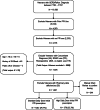Proton pump inhibitor prescriptions and subsequent use in US veterans diagnosed with gastroesophageal reflux disease
- PMID: 23400526
- PMCID: PMC3682032
- DOI: 10.1007/s11606-013-2345-0
Proton pump inhibitor prescriptions and subsequent use in US veterans diagnosed with gastroesophageal reflux disease
Abstract
Background: Empiric proton pump inhibitor use is common for gastroesophageal reflux disease (GERD), but initial proton pump inhibitor (PPI) prescription patterns in Veterans are unknown.
Objective: The study aims were to determine initial PPI prescriptions in Veterans diagnosed with GERD, and to characterize subsequent PPI use over the 2 years following initial prescription.
Design: We conducted a retrospective study using Veteran's Administration (VA) administrative data and chart review.
Study population: Patients diagnosed with GERD and provided an initial PPI prescription at Hines VA Hospital from 2003 to 2007, with 2 year follow-up for each patient (through 2009). MEASURES AND OUTCOMES: Initial PPI prescriptions were categorized as standard total daily dose or high total daily dose, and accuracy was confirmed by manual chart review. Descriptive statistics were calculated and bivariate analyses were used to assess for differences in demographics, prescriptions, and subsequent use by initial PPI dosage category.
Results: Of the 1,621 patients included in the study, 378 (23.3 %) had high total daily dose initial PPI prescriptions and 1,243 (76.7 %) patients had standard total daily dose initial prescriptions. The majority of patients (65.8 %) received a 90-day or greater initial prescription. Over the 2 years following the initial PPI prescription, 13.0 % of patients with initial standard daily dose prescriptions had evidence of step-up therapy. Only 7.1 % of patients with initial high daily dose PPI prescriptions had evidence of step-down therapy. A large majority of patients (83.8 %) had at least one refill over 2 years, and the overall medication possession ratio was 0.86.
Conclusions: Many Veterans receive high total daily dose PPI prescriptions as initial therapy for a GERD diagnosis, and few patients have evidence for cessation or reduction of therapy. These results provide detailed data on prescribing and use of PPIs to help guide efforts for optimal PPI use in US Veterans.
Figures
Comment in
-
Capsule commentary on Gawron et al., proton pump inhibitor prescriptions and subsequent use in US veterans diagnosed with gastroesophageal reflux disease.J Gen Intern Med. 2013 Jul;28(7):950. doi: 10.1007/s11606-013-2352-1. J Gen Intern Med. 2013. PMID: 23371386 Free PMC article. No abstract available.
Similar articles
-
Gastroesophageal reflux disease in primary care: using changes in proton pump inhibitor therapy as an indicator of partial response.Scand J Gastroenterol. 2012 Jul;47(7):751-61. doi: 10.3109/00365521.2012.679682. Epub 2012 Apr 23. Scand J Gastroenterol. 2012. PMID: 22519917
-
Effect of on-demand vs continuous prescription of proton pump inhibitors on symptom burden and quality of life: results of a real-world randomized controlled trial in primary care patients with gastroesophageal reflux disease.Ann Med. 2024 Dec;56(1):2354683. doi: 10.1080/07853890.2024.2354683. Epub 2024 May 16. Ann Med. 2024. PMID: 38753973 Free PMC article. Clinical Trial.
-
Prescribing Patterns of Proton Pump Inhibitors in Germany: A Retrospective Study Including 472 146 Patients.J Prim Care Community Health. 2023 Jan-Dec;14:21501319231221002. doi: 10.1177/21501319231221002. J Prim Care Community Health. 2023. PMID: 38142444 Free PMC article.
-
Gastroesophageal Reflux Disease: A Review.JAMA. 2020 Dec 22;324(24):2536-2547. doi: 10.1001/jama.2020.21360. JAMA. 2020. PMID: 33351048 Review.
-
The evolution of proton pump inhibitors for the treatment of gastroesophageal reflux disease.J Am Acad Nurse Pract. 2010 Dec;22(12):674-83. doi: 10.1111/j.1745-7599.2010.00578.x. Epub 2010 Nov 24. J Am Acad Nurse Pract. 2010. PMID: 21129076 Review.
Cited by
-
Low-Value Proton Pump Inhibitor Prescriptions Among Older Adults at a Large Academic Health System.J Am Geriatr Soc. 2019 Dec;67(12):2600-2604. doi: 10.1111/jgs.16117. Epub 2019 Sep 5. J Am Geriatr Soc. 2019. PMID: 31486549 Free PMC article.
-
Food, Acid Supplementation and Drug Absorption - a Complicated Gastric Mix: a Randomized Control Trial.Pharm Res. 2019 Sep 4;36(11):155. doi: 10.1007/s11095-019-2693-5. Pharm Res. 2019. PMID: 31485804 Free PMC article. Clinical Trial.
-
Proton Pump Inhibitors and Risk of Incident CKD and Progression to ESRD.J Am Soc Nephrol. 2016 Oct;27(10):3153-3163. doi: 10.1681/ASN.2015121377. Epub 2016 Apr 14. J Am Soc Nephrol. 2016. PMID: 27080976 Free PMC article.
-
Patient Awareness of Reported Adverse Effects Associated with Proton Pump Inhibitors in a Medically Underserved Community.Healthcare (Basel). 2020 Nov 19;8(4):499. doi: 10.3390/healthcare8040499. Healthcare (Basel). 2020. PMID: 33228241 Free PMC article.
-
Binding of omeprazole to protein targets identified by monoclonal antibodies.PLoS One. 2020 Sep 18;15(9):e0239464. doi: 10.1371/journal.pone.0239464. eCollection 2020. PLoS One. 2020. PMID: 32946534 Free PMC article.
References
-
- Caro JJ, Salas M, Ward A. Healing and Relapse Rates in Gastroesophageal Reflux Disease Treated with the Newer Proton-Pump Inhibitors Lansoprazole, Rabeprazole, and Pantoprazole Compared with Omeprazole, Ranitidine, and Placebo: Evidence from Randomized Clinical Trials. Clin Ther. 2001;23:998–1017. doi: 10.1016/S0149-2918(01)80087-4. - DOI - PubMed
Publication types
MeSH terms
Substances
Grants and funding
LinkOut - more resources
Full Text Sources
Other Literature Sources
Medical


